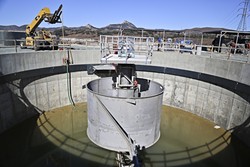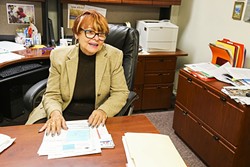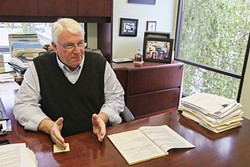It's never been easy: The Los Osos Community Services District hits another set of financial snags as it tries to plan for the future
By Peter Johnson[{
"name": "Ad - Medium Rectangle CC01 - 300x250",
"id": "AdMediumRectangleCC01300x250",
"class": "inlineCenter",
"insertPoint": "8",
"component": "2963441",
"requiredCountToDisplay": "12"
},{
"name": "Ad - Medium Rectangle LC01 - 300x250",
"id": "AdMediumRectangleCC01300x250",
"class": "inlineCenter",
"insertPoint": "18",
"component": "2963441",
"requiredCountToDisplay": "22"
},{
"name": "Ad - Medium Rectangle LC09 - 300x250",
"id": "AdMediumRectangleLC09300x250",
"class": "inlineCenter",
"insertPoint": "28",
"component": "3252660",
"requiredCountToDisplay": "32"
}]
View a slideshow of the current state of the Los Osos watewater plant.
A $189-million wastewater treatment plant is tucked away in Los Osos farmland, with the crystal-clear Sisters peaks as a backdrop. It’s not finished yet, but it’s close.
Inside, deep canals of concrete make space for wastewater; color-coded pumps and pipes twist through the site; and odor eliminators are waiting to do their job. Offices and labs await administrators and scientists.
Come March, 49 miles of pipeline crisscrossing Los Osos will begin funneling sewage to the plant. The treatment facility will churn out millions of gallons of treated water to go toward replenishing the Los Osos Valley Basin.
This costly facility, SLO County’s second most expensive project ever (second to the Nacimiento water project), did not come about smoothly or efficiently. Years of conflict and stagnancy plagued the Los Osos Community Services District (LOCSD) while it debated the sewer system: Elected officials were recalled, the district filed for bankruptcy twice*, and the community was in turmoil.
Now, after decades of waiting, Los Osos can finally begin efforts to solve its water woes.
“It’s virtually impossible to solve the Los Osos drinking water problem without solving the wastewater problem,” said Bruce Gibson, SLO County 2nd District supervisor. “The deployment of that treated water is really the key to making everything else work.”
Why? Because five years of drought and seawater intrusion threaten to decommission the Los Osos water basin altogether.
On Oct. 14, a SLO County Superior Court judge ended the LOCSD’s 11-year struggle to get a basin management plan approved, just one week after the district placed its general manager under investigation for financial mismanagement concerns.
With one foot moving forward and one foot stuck in controversy, Los Osos is once again unsure of the future of its Community Services District or the future of its water supply.
‘Bowl of spaghetti’
Uneasiness permeates the LOCSD Board of Directors meeting room at 9 p.m. on Nov. 5. District staff and dozens of concerned residents are present.
At the previous meeting, the Board of Directors voted to hire an investigator to examine allegations that Kathy Kivley, the district’s general manager, misappropriated district funds.
The board’s decision came after a scathing financial audit of the district’s 2013-2014 books outlined untraceable accounting, the overriding of internal controls by the general manager, and improper petty cash purchases, among other items.
Kivley declined to comment to New Times on the investigation. She instead chose to reiterate her goals as general manager.
“My goal is to make sure this CSD is financially sound for the first time in many, many years,” Kivley said.
Following the audit, the Board of Directors asked Kivley to write a response to the audit findings. The recently released letter states: “There were extensive discussions with the district accountant … regarding all potential journal entries prior to making changes.”
Kivley also wrote that a previous accountant didn’t utilize the accounting software that the district is supposed to use. As the district started using the software, management discovered “numerous discrepancies in the bankruptcy, liabilities, reserves, and bank statements from prior years.”
When board member Chuck Cesena pressed Kivley with questions at the Nov. 5 meeting, district accountant Mike Doyle spoke up to defend the letter. He told the board that they received incorrect financial reports in prior years.
“There’s absolutely no dispute about that,” Doyle said. “All I’m telling you is the situation I inherited, and the situation which I am trying to rectify.”
Michael Wright, president of the LOCSD Board of Directors, believes that the confusion is a result of the district modernizing its accounting practices.
“In the process of automating it, it’s like peeling an onion,” he said. “You have to go back … . Things weren’t done in a timely manner. We were months and months behind on bank reconciliations.”
Wright said that the financial problems weren’t limited to 2013-2014. When he took his seat on the board in 2011, the district wrote off revenue statements of $1.7 million and $400,000 because they couldn’t find it and couldn’t trace it to a source or date.
The LOCSD received a clean audit for 2012-2013. Kivley was hired in October 2013.
“I think [Kivley’s] done a great job considering what she walked into,” he said.
Whether the recent audit was the fault of past management or present, it is cloaking the district in suspicion and has halted forward progress. On Nov. 5, the board rejected a motion to “receive and file” a basic monthly financial report, and it also voted to delay a routine agenda item of destroying old district records.
“Given the current climate, the destruction of any records makes me nervous,” Cesena said.
Some members of the public expressed a desire for the board to bring in an independent party to dig deeper into the confusion—or the “bowl of spaghetti” as it was referred to in the meeting.
“You need to find someone to untangle this,” said Julie Tacker, a former board member. “Or else this is going to erode our confidence in the board.”
The investigation into Kivley is still ongoing.
Newest to the board of directors is Jon-Erik Storm, who told New Times that the financial convolution is a concern and he’s not fond of management’s tone, which he thinks borders on defensive. He hopes the issues get resolved so the CSD can move on.
“We need to have a conversation in our town about what our future is,” Storm said. “But how do you have that when we have these issues with the finances? It’s very frustrating to all of us.”
Time for more work
At least on Oct. 14, Los Osos received some good news. A SLO County Superior Court signed off on the Los Osos Water Basin Management Plan, an agreement between the basin’s three purveyors to take steps in salvaging a basin in trouble.
The decision concluded 11 long years of negotiations between the LOCSD, Golden State Water, and S&T Mutual.
“It should have been done sooner,” SLO County Supervisor Gibson said of the plan. “We’ve got a situation that needs to be fixed.”
The Los Osos water basin covers 10 square miles and lies just below the 15,000 residents it serves. It’s split by a midline layer of clay that divides the basin into upper and lower aquifers.
The upper aquifer is contaminated by a septic tank sewer system that was supposed to be replaced decades ago.
The lower aquifer, where most water is drafted, is drying up fast. The drought exacerbates the rate of depletion because percolating rain is the only way the basin can refill itself.
As the water level in the lower aquifer diminishes, neighboring seawater encounters less resistance and can permeate the basin. Seawater intrusion has sharply accelerated since 2005. The rate of intrusion was 60 feet per year between 1985 and 2005. In the past decade, it’s increased to a rate of 250 feet per year, according to data in the Basin Plan.
“We have to turn it around,” LOCSD Board President Wright said.
The Basin Management Plan outlines a detailed and ambitious strategy to halt the seawater intrusion by strengthening water efficiency and conservation, installing nitrate removal facilities, and utilizing recycled water from the wastewater treatment facility to help recharge the basin.
Wright said that progress on the Basin Management Plan picked up significantly in the last three years.
For the prior eight years, the LOCSD was walking through financial molasses caused by two bankruptcies* in 2006 and 2011.
“You’re basically frozen in time,” Wright said of the district’s bankruptcy. “Everything is watched and locked down. You just have to go through that process.
“Now the hard work begins,” he said.
With the plan approved, the LOCSD will appoint a member of its Board of Directors to serve on the Basin Management Committee, a new government entity comprised of one representative from each party in the Basin Management Plan. The committee will be tasked with executing the plan beginning in December.
Salvaging the Los Osos water basin won’t be simple, fast, or cheap.
A proposed $30 million in infrastructure improvements are included in the plan. With the help of a grant, the LOCSD is testing a nitrate removal process at its South Bay Well, which, if successful, would enable water to be drafted from the upper aquifer to reduce what’s pulled out of the lower aquifer.
Wright told New Times that LOCSD water customers who are in the wastewater treatment plant’s “prohibition zone” (those are the residents set to fork out roughly $200 extra a month to pay for the new sewer system) will not be included in the funding for the Basin Management Plan.
“There’s no way I can see us charging the prohibition zone people even more than they already have been,” he said. “We can structure it where we won’t have to ask them for more money.”
However, assurances from Wright come into conflict with the language in the basin plan.
“All water-using properties should pay for the cost of achieving a sustainable basin under current conditions, because all such properties contributed to the overall decline in basin conditions,” the basin plan states.
Funding discussions about potential water rate increases will take place in the Basin Management Committee meetings in the coming months.
The LOCSD has already raised its water rates since the drought started. While it used to offer cheaper water compared to competitors Golden State Water and S&T Mutual, the district’s rates are now about equal.
“We’re going to try to hold the line on our rates the best we can,” Wright said.
If the plan doesn’t work, there are contingencies. Los Osos could theoretically surrender the basin and build a water pipeline to flow water over from the city of SLO, but that pipe would cost $13.5 million.
“It’s extremely important that we as purveyors work very, very hard to make this basin whole,” General Manager Kivley said. “Otherwise, there’s not reason for us.”
The crossroads
Board member Storm knows that there are some people in Los Osos who would be just fine with not having a community services district at all.
“That’s a fair question to ask,” he said. “Ultimately, I don’t think that’s something we want.”
Storm sees unexplored opportunities for the district. He wants the district to get more involved in parks. Even though parks technically fall under the district’s authority, the lone park in Los Osos is operated by the county.
But mostly, Storm wants to see Los Osos politics become less hostile.
“We’re sort of at a crossroads,” Storm said. “We have a history of fighting, and people are still polarized along those lines. To do anything positive, we need to get past that.”
Kivley echoed that sentiment.
“Our goal is not to have controversy,” Kivley said. “Our goal is to operate as a water district and a fire district, as we should, and provide the best quality service to our community.”
Storm, the newest and youngest board member, carries with him the public feedback he heard while campaigning door-to-door in Los Osos prior to the 2014 election.
“The sense was, the less they hear about [the district] the happier they are,” Storm said. “We aren’t there to lead a social revolution. We’re there to make sure the water is safe, clean, and affordable.”
Despite efforts to stay the course, resentment from the past is just below the surface.
“We have a royal battleground politically here,” resident Al Barrow reminded locals at the Nov. 5 board meeting. “There’s blood all over it.”
Avoiding controversy has proven to be difficult for a district that’s experienced so much grief. Disagreement over the sewer project practically destroyed community morale, according to the sources that spoke with New Times. Pandora Nash-Karner, one of the members of the LOCSD Board during its conception in 1998, remembers the district’s earlier years as a tough time.
“We’re a whole lot better as a community and as a group of people than some of our behavior suggests,” Nash-Karner said. “I’m really looking forward to once this sewer is in, so that we can spend our energy elsewhere.”
Why is there so much anguish in Los Osos politics? Storm points out the fact that the district stands as the sole civic platform for a community of 15,000.
“Los Osos almost should be a city,” Storm said. “The CSD is the only local government we have. People want that kind of forum where local issues can be handled by local people, but we don’t really have that.”
Nevertheless, the LOCSD is heading into the big government challenge of enacting the Los Osos Basin Management Plan in a smart and efficient manner.
Board President Wright is hopeful the district will gain back the confidence of, well, just about everyone along the way.
“We’re still proving ourselves … . We’re not done proving ourselves,” Wright said. “But it’s much better now than it has been.”
Editorial intern Peter Johnson can be reached at [email protected].
* CORRECTION: New Times incorrectly stated the number of times the Los Osos Community Services District filed for bankruptcy. The LOCSD filed for bankruptcy one time, in 2006, and a bankruptcy plan was approved in 2011. NOV. 18, 2015.
Latest in News
Readers also liked…
-

Coast Unified teachers upset over new position's salary and qualifications
Oct 20, 2022 -

SLO police identify alleged driver who hit and killed couple
Dec 22, 2022 -

When the levee breaks: Oceano residents, county officials walk a tightrope of regulations to manage Arroyo Grande Creek, which some say led to the levee's failure in January
May 18, 2023













